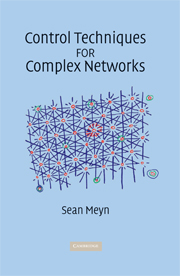1 - Introduction
Published online by Cambridge University Press: 17 March 2011
Summary
Network models are used to describe power grids, cellular telecommunications systems, large-scale manufacturing processes, computer systems, and even systems of elevators in large office buildings. Although the applications are diverse, there are many common goals:
(i) In any of these applications one is interested in controlling delay, inventory, and loss. The crudest issue is stability: do delays remain bounded, perhaps in the mean, for all time?
(ii) Estimating performance, or comparing the performance of one policy over another. Performance is of course context-dependent, but common metrics are average delay, loss probabilities, or backlog.
(iii) Prescriptive approaches to policy synthesis are required. A policy should have reasonable complexity; it should be flexible and robust. Robustness means that the policy will be effective even under significant modeling error. Flexibility requires that the system respond appropriately to changes in network topology, or other gross structural changes.
In this chapter we begin in Section 1.1 with a survey of a few network applications, and the issues to be explored within each application. This is far from comprehensive. In addition to the network examples described in the Preface, we could fill several books with applications to computer networks, road traffic, air traffic, or occupancy evolution in a large building.
Although complexity of the physical system is both intimidating and unavoidable in typical networks, for the purposes of control design it is frequently possible to construct models of reduced complexity that lead to effective control solutions for the physical system of interest.
- Type
- Chapter
- Information
- Control Techniques for Complex Networks , pp. 1 - 22Publisher: Cambridge University PressPrint publication year: 2007

